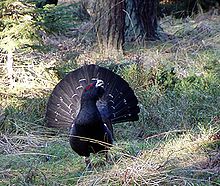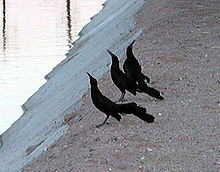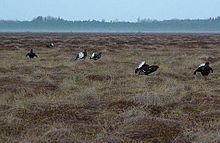
Sexual selection is a mode of natural selection in which members of one biological sex choose mates of the other sex to mate with, and compete with members of the same sex for access to members of the opposite sex. These two forms of selection mean that some individuals have greater reproductive success than others within a population, for example because they are more attractive or prefer more attractive partners to produce offspring. Successful males benefit from frequent mating and monopolizing access to one or more fertile females. Females can maximise the return on the energy they invest in reproduction by selecting and mating with the best males.

Grouse are a group of birds from the order Galliformes, in the family Phasianidae. Grouse are presently assigned to the tribe Tetraonini, a classification supported by mitochondrial DNA sequence studies, and applied by the American Ornithologists' Union, ITIS, International Ornithological Congress, and others.

Sexual dimorphism is the condition where sexes of the same species exhibit different morphological characteristics, particularly characteristics not directly involved in reproduction. The condition occurs in most dioecious species, which consist of most animals and some plants. Differences may include secondary sex characteristics, size, weight, color, markings, or behavioral or cognitive traits. Male-male reproductive competition has evolved a diverse array of sexually dimorphic traits. Aggressive utility traits such as "battle" teeth and blunt heads reinforced as battering rams are used as weapons in aggressive interactions between rivals. Passive displays such as ornamental feathering or song-calling have also evolved mainly through sexual selection. These differences may be subtle or exaggerated and may be subjected to sexual selection and natural selection. The opposite of dimorphism is monomorphism, when both biological sexes are phenotypically indistinguishable from each other.
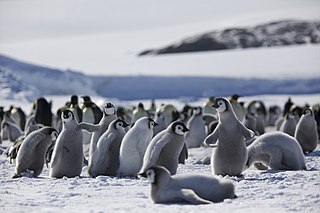
Behavioral ecology, also spelled behavioural ecology, is the study of the evolutionary basis for animal behavior due to ecological pressures. Behavioral ecology emerged from ethology after Niko Tinbergen outlined four questions to address when studying animal behaviors: What are the proximate causes, ontogeny, survival value, and phylogeny of a behavior?
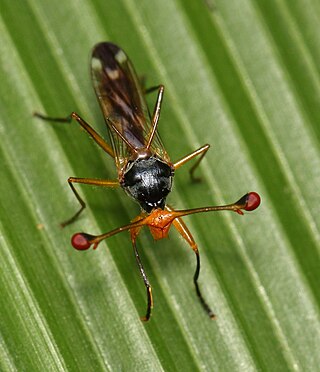
Stalk-eyed flies are insects of the fly family Diopsidae. The family is distinguished from most other flies by most members of the family possessing "eyestalks": projections from the sides of the head with the eyes at the end. Some fly species from other families such as Drosophilidae, Platystomatidae, Richardiidae, and Tephritidae have similar heads, but the unique character of the Diopsidae is that their antennae are located on the stalk, rather than in the middle of the head as in all other flies. Stalked eyes are present in all members of the subfamily Diopsinae, but are absent in the Centrioncinae, which retain unstalked eyes similar to those of other flies. The stalked eyes are usually sexually dimorphic, with eyestalks present but shorter in females.

Display behaviour is a set of ritualized behaviours that enable an animal to communicate to other animals about specific stimuli. Such ritualized behaviours can be visual, but many animals depend on a mixture of visual, audio, tactical and chemical signals. Evolution has tailored these stereotyped behaviours to allow animals to communicate both conspecifically and interspecifically which allows for a broader connection in different niches in an ecosystem. It is connected to sexual selection and survival of the species in various ways. Typically, display behaviour is used for courtship between two animals and to signal to the female that a viable male is ready to mate. In other instances, species may make territorial displays, in order to preserve a foraging or hunting territory for its family or group. A third form is exhibited by tournament species in which males will fight in order to gain the 'right' to breed. Animals from a broad range of evolutionary hierarchies avail of display behaviours - from invertebrates such as the simple jumping spider to the more complex vertebrates like the harbour seal.

Sexual conflict or sexual antagonism occurs when the two sexes have conflicting optimal fitness strategies concerning reproduction, particularly over the mode and frequency of mating, potentially leading to an evolutionary arms race between males and females. In one example, males may benefit from multiple matings, while multiple matings may harm or endanger females, due to the anatomical differences of that species. Sexual conflict underlies the evolutionary distinction between male and female.

Mate choice is one of the primary mechanisms under which evolution can occur. It is characterized by a "selective response by animals to particular stimuli" which can be observed as behavior. In other words, before an animal engages with a potential mate, they first evaluate various aspects of that mate which are indicative of quality—such as the resources or phenotypes they have—and evaluate whether or not those particular trait(s) are somehow beneficial to them. The evaluation will then incur a response of some sort.

The sexy son hypothesis in evolutionary biology and sexual selection, proposed by Patrick J. Weatherhead and Raleigh J. Robertson of Queen's University in Kingston, Ontario in 1979, states that a female's ideal mate choice among potential mates is one whose genes will produce males with the best chance of reproductive success. This implies that other benefits the father can offer the mother or offspring are less relevant than they may appear, including his capacity as a parental caregiver, territory and any nuptial gifts. Fisher's principle means that the sex ratio is always near 1:1 between males and females, yet what matters most are her "sexy sons'" future breeding successes, more likely if they have a promiscuous father, in creating large numbers of offspring carrying copies of her genes. This sexual selection hypothesis has been researched in species such as the European pied flycatcher.

The lek paradox is the conundrum of how additive or beneficial genetic variation is maintained in lek mating species in the face of consistent sexual selection based on female preferences. While many studies have attempted to explain how the lek paradox fits into Darwinian theory, the paradox remains. Persistent female choice for particular male trait values should erode genetic diversity in male traits and thereby remove the benefits of choice, yet choice persists. This paradox can be somewhat alleviated by the occurrence of mutations introducing potential differences, as well as the possibility that traits of interest have more or less favorable recessive alleles.

A courtship display is a set of display behaviors in which an animal, usually a male, attempts to attract a mate; the mate exercises choice, so sexual selection acts on the display. These behaviors often include ritualized movement ("dances"), vocalizations, mechanical sound production, or displays of beauty, strength, or agonistic ability.
In the evolutionary biology of sexual reproduction, operational sex ratio (OSR) is the ratio of sexually competing males that are ready to mate to sexually competing females that are ready to mate, or alternatively the local ratio of fertilizable females to sexually active males at any given time. This differs from physical sex ratio which simply includes all individuals, including those that are sexually inactive or do not compete for mates.

Many species have multiple sexual ornaments, whereby females select mating partners using several cues instead of only one cue. Whereas this phenomenon is self-evident and hence long recognized, adaptive explanations of why females use several instead of only one signal have been formulated relatively recently. Several hypotheses exist, but mutually exclusive tests are still lacking.
A mating call is the auditory signal used by animals to attract mates. It can occur in males or females, but literature is abundantly favored toward researching mating calls in females. In addition, mating calls are often the subject of mate choice, in which the preferences of one gender for a certain type of mating call can drive sexual selection in a species. This can result in sympatric speciation of some animals, where two species diverge from each other while living in the same environment.

Mate-choice copying, or non-independent mate choice, occurs when a female of an animal species copies another fellow female's mate choice. In other words, non-independent mate-choice is when a female's sexual preferences get socially inclined toward those of their fellow females. This behavior is speculated to be one of the driving forces of sexual selection and the evolution of male traits. It is also hypothesized that mate-choice copying can induce speciation due to the selective pressure for certain, preferred male qualities. Moreover, mate-choice copying is one form of social learning in which animals behave differently depending on what they observe in their surrounding environment. In other words, the animals tend to process the social stimuli they receive by observing the behavior of their conspecifics and execute a similar behavior to what they observed. Mate choice copying has been found in a wide variety of different species, including : invertebrates, like the common fruit fly ; fish, such as guppies and ocellated wrasse; birds, like the black grouse; and mammals, such as the Norway rat and humans. Most studies have focused on females, but male mate copying has been also found in sailfin mollies and humans.
A biological ornament is a characteristic of an animal that appears to serve a decorative function rather than a utilitarian function. Many are secondary sexual characteristics, and others appear on young birds during the period when they are dependent on being fed by their parents. Ornaments are used in displays to attract mates, which may lead to the evolutionary process known as sexual selection. An animal may shake, lengthen, or spread out its ornament in order to get the attention of the opposite sex, which will in turn choose the most attractive one with which to mate. Ornaments are most often observed in males, and choosing an extravagantly ornamented male benefits females as the genes that produce the ornament will be passed on to her offspring, increasing their own reproductive fitness. As Ronald Fisher noted, the male offspring will inherit the ornament while the female offspring will inherit the preference for said ornament, which can lead to a positive feedback loop known as a Fisherian runaway. These structures serve as cues to animal sexual behaviour, that is, they are sensory signals that affect mating responses. Therefore, ornamental traits are often selected by mate choice.

Sexual selection in birds concerns how birds have evolved a variety of mating behaviors, with the peacock tail being perhaps the most famous example of sexual selection and the Fisherian runaway. Commonly occurring sexual dimorphisms such as size and color differences are energetically costly attributes that signal competitive breeding situations. Many types of avian sexual selection have been identified; intersexual selection, also known as female choice; and intrasexual competition, where individuals of the more abundant sex compete with each other for the privilege to mate. Sexually selected traits often evolve to become more pronounced in competitive breeding situations until the trait begins to limit the individual's fitness. Conflicts between an individual fitness and signaling adaptations ensure that sexually selected ornaments such as plumage coloration and courtship behavior are "honest" traits. Signals must be costly to ensure that only good-quality individuals can present these exaggerated sexual ornaments and behaviors.

Sexual selection in mammals is a process the study of which started with Charles Darwin's observations concerning sexual selection, including sexual selection in humans, and in other mammals, consisting of male–male competition and mate choice that mold the development of future phenotypes in a population for a given species.

Sexual selection in scaled reptiles studies how sexual selection manifests in snakes and lizards, which constitute the order Squamata of reptiles. Each of the over three thousand snakes use different tactics in acquiring mates. Ritual combat between males for the females they want to mate with includes topping, a behavior exhibited by most viperids in which one male will twist around the vertically elevated fore body of its opponent and forcing it downward. It is common for neck biting to occur while the snakes are entwined.

Sexual selection in amphibians involves sexual selection processes in amphibians, including frogs, salamanders and newts. Prolonged breeders, the majority of frog species, have breeding seasons at regular intervals where male-male competition occurs with males arriving at the waters edge first in large number and producing a wide range of vocalizations, with variations in depth of calls the speed of calls and other complex behaviours to attract mates. The fittest males will have the deepest croaks and the best territories, with females making their mate choices at least partly based on the males depth of croaking. This has led to sexual dimorphism, with females being larger than males in 90% of species, males in 10% and males fighting for groups of females.

